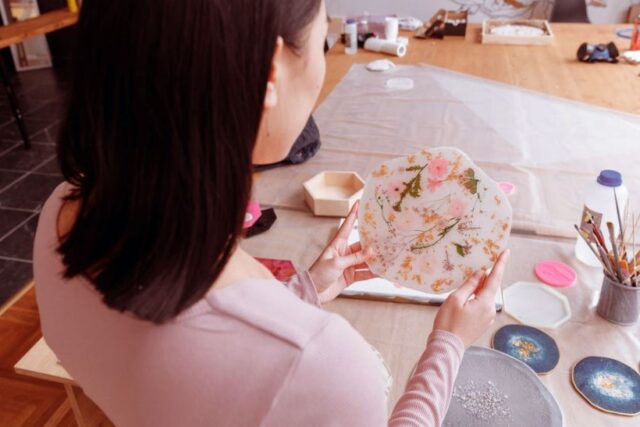ABS statistics show that over 2 million (10%) Australians engage in arts and crafts practice, including jewellery making, textile crafts, wood crafts etc. In the past year, over 696,500 people who engaged in arts and crafts involving glass, ceramics, clay, mosaic, and resin purchased raw materials like resin moulds online.
Significant Characteristics of Resin
The main features of the resin include its durability, excellent strength, superior chemical resistance, and mechanical qualities. It also has electrical insulation capabilities, long-lasting shelf life, and resistance to impact. Resin has the characteristic to take any shape possible. Therefore, craft enthusiasts use resin moulds to create different shapes and designs for their art and jewellery pieces. Resin is a popular material used in commercial, industrial and craft projects and DIY items.
Let’s Understand What Resin Is.
Resin is a natural compound that is highly viscous and has a plant-based or synthetic origin. It consists of two-component parts, terpenes and resin acids. When resin mixes with a hardener, the chemicals start to bind the molecules present in the resin, causing a chemical reaction. It slowly hardens the resin from its liquid state into a solid. This solid is a durable plastic substance that gets the name resin.
Types of Resin Available in the Market
Resin is available in two different forms based on chemical formation, origin and synthesis.
Natural Resin
It is also known as a resin plant, as it originates from plants and natural resources. Manufacturers can extract it in multiple ways through the whole plant, plant’s injury or incision of a specific part. Most popularly, the plant-based resin comes from ginger and capsicum plants.
Synthetic Resin
This type is not obtained from nature but in industries. Manufacturers cure rigid polymers to make synthetic resin. During the curing process, it produces various substances. These include acrylic glass, epoxy resins, casting resins, thermoplastic resin, acetyl resins, and ion exchange resin.
Below Mentioned Are Some Properties of Resin
– It has a transparent, solid or semi-solid structure.
– A slow oxidation process occurs when resin gets exposed to the atmosphere, resulting in a darker colour.
– It is insoluble in water
– It is soluble in alcohol, chloral hydrate, and volatile oils.
– Water is lighter than resin because it has a specific gravitational pull.
Anyone can make beautiful art and crafts using this resin. Wondering how? Scroll down to know more about it!
How Crafters Use Silicon Resin Moulds and Plastic Moulds to Create Their Pieces
Silicon Moulds
The best part about these moulds is that they are reusable. They can also last for many years with proper care. People can make 3D resin artwork by pouring liquid resin into these moulds. Compared to plastic moulds, silicone moulds are friendlier, as they repel the resin, allowing individuals to remove them easily. One can make charming objects using these moulds and reuse them multiple times! But they are two to three times more expensive than plastic moulds. One can also make resin moulds by using two-part silicone at home.
Plastic Moulds
The plastic moulds come from polypropylene or polyethene sheets. As they are made from a synthetic template, they are not very flexible. They are also reusable but not as many times as silicone moulds. One need not worry about their expenditure on these moulds as they are not very expensive. But the resin product from plastic moulds does not have a shiny and bright finish. One has to recoat them again with another layer of resin or use a gloss spray to create the shine. People can’t make their own plastic resin castings as they require machinery.

Lastest Posts
Marketing
Advancements in Solar Panel Technology: Illuminating the Path to a Sustainable Future
Lifestyle
How to Build a Capsule Wardrobe: Essentials for Every Man
Lifestyle
Women in the Catholic Church: Roles, Recognition, and Calls for Change
Marketing
Experiential Marketing for Brands: Crafting Unforgettable Consumer Connections
Banking & Finance
Understanding the Case-Shiller Home Price Index and Its Multiple Merits
Business
Why Handmade Goods Are Often Better in Quality
Lifestyle
Efficient Home Water Management: Tips For Saving Water And Energy With Smart Gadgets